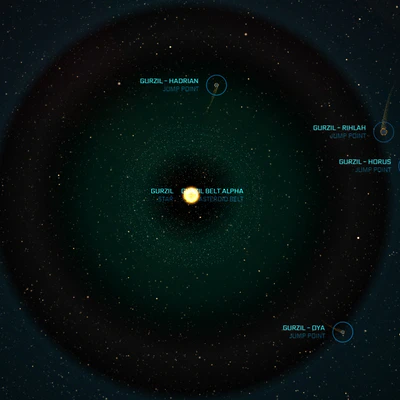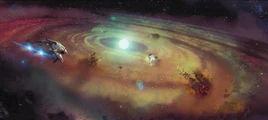Quick facts:Gurzil system
The Gurzil system is a single star planetary system in the United Empire of Earth (UEE). It is a system in the earliest stages of development, where humanity could study the phenomenon up close and better understand the answers to those questions asked since antiquity. Sadly, the fear and paranoia of the era restricted scientific access to the system and kept it shrouded in a fog of war for almost three hundred years.
Due to the protoplanetary disc, visibility in Gurzil is still a constant danger. Exercise caution when traveling through the system and be mindful of all hazards (both natural and sentient).[1]
"That's when I knew I was destined to fly. To have survived such a horrible thing and have 'when can I get back out there' be the one thought that pushed me through the really hard times… I don't know. It's weird, right?"
Dahunsil Kosoko, 2940[1]
"You go in, I say there's a fifty-fifty shot of coming out again. That's the gamble with the Dark Sea. Might've even gotten a lot of people killed, going in with that fear. Not me. I'll take an even split."
Lt. Demian Ward, UEEN (Ret), Hunter Killer: My Life on the Xi'an Front[1]
History
The Dark Sea
The mid-26th century was a complicated period in Humanity's evolution into the stars. Technological advances made jump point scanners considerably more affordable to the public, allowing more and more civilians to compete with 'professional' pathfinders. That period of rapid expansion came to a screeching halt when Gaia Planet Services began terraforming a planet in what would be known as the Th.us'ūng system (coined Pallas by the UEE) without realizing that the planet was already inhabited by another species. The following fifty-seven days gave Humanity a sobering introduction to the Xi'an Empire as they negotiated the release of the terraformers. For the first few years after the Pallas Incident, there were only two known systems connected to Xi'an space. In 2531, Teesa Morrison discovered the Baker-Hadur jump point. While denied the lasting legacy inherent in discovering a new system, she enjoyed a brief period of celebrity after her flight footage found its way to the NewsOrgs. In it, her very vocal bouts of exultation upon successfully completing the jump turned to shrieks of fear when she found herself face to face with a fleet of Xi'an military ships on the other side. The prospect of hunting for jump points had become considerably more complicated. In response, the UPE created the Imperial Cartography Center (ICC) to consolidate into one agency their effort to scan for jump points and chart new systems. They also instituted a series of intensive policies to make sure that every military NavJumper was trained in diplomatic protocols and procedures in an effort to avoid any potential conflicts. Dahunsil Kosoko was undeterred by the danger. After spending eight months recovering from a ship crash that took one of his legs, Kosoko stepped out of the medstation in Prime, picked up some Toreador's for lunch, and got himself a new ship. After picking up supplies, he made his way to the Hadrian System (then called Nivelin) with the goal of 'scanning his way across the 'verse.' He wouldn't make it that far. After only three weeks of intensive scans in 2539, he discovered a jump point into the Gurzil system. Arriving on the other side of the jump, Kosoko half expected to find a Xi'an fleet waiting, but found something much more impressive: a protoplanetary disc of gas and minerals swirling around a K-Type Main Sequence star. The system was arguably the scientific discovery of the century, offering the research community unprecedented access to the foundation of a system. Kosoko filed his discovery paperwork to name the system Odara, after his aunt, but unfortunately, the UPE had to intercede. In 2542, while ICC surveyors were still assessing the system, a Xi'an scout ship appeared in the system via another (previously unknown) jump point. The Xi'an turned out to be another explorer, perhaps their version of Teesa Morrison, so while Odara system wasn't already part of the Xi'an Empire, it was connected to it. Specifically, it was connected to the system R.il'a, home to the military world Shorvu. The UPE quickly withdrew its surveyors and declared the system off limits to civilians. The system was promptly renamed from Odara to the standard military convention adopted by all systems that comprised the Perry Line: gods of war. Named after the ancient Berber deity, Gurzil, the sprawling disc of coalescing planetary matter made the system impossible to effectively monitor, giving birth to its secondary and even more ominous name: the Dark Sea. Over the next two centuries, Gurzil would be the location of numerous military operations and dozens of casualties. Although the official cause of death was always attributed to collisions resulting from the poor visibility, rumors swirled that Xi'an military assassin teams and pockets of Tevarin refugees hiding in the clusters were actually responsible.[1]
After the fall
In the aftermath of the Messer regime, the Perry Line underwent a fundamental change. Imperator Toi attempted to honor the promises outlined in the Akari-Kray Peace Accord and dismantle the Perry Line, dividing the systems between the Humans and Xi'an. Despite having no planets, Gurzil was heavily pursued by members of the UEE for both its scientific relevance as well as its vast resources. Once the system had been acquired by the UEE, a fascinating debate erupted in the Senate. With the adoption of the Fair Chance Act in 2795, guaranteeing the protection of developing species, advocates for the scientific community and lobbyists for the mining consortiums found themselves at odds over what exactly to do with Gurzil. While the mining companies supported scientific study in the system, scientists claimed that Gurzil should fall under the protection of the Fair Chance Act, claiming that its composition and star had all the elements to ultimately develop into a system with habitable planets and thus, life. They believed that attempting to harvest the minerals in the system would irrevocably interfere with the system's development and therefore jeopardize the possibility of life developing naturally. Their counterparts, however, argued that they were talking about a timeline of millions and possibly hundreds of millions of years.[1]
The modern state
The debate over Gurzil has continued in some form or another ever since. Although the UEE has severely restricted mining within the green band of the system, they have not officially placed it under the protection of the Fair Chance Act. Regardless of its use, Gurzil system offers travelers a unique insight into the birth of a solar(star?) system. Travelling through the system, you will find no shortage of scientific and research stations, trying to unlock the secrets of the universe, as well as mining operations beyond the frost line. Visitors are advised to try one of the many scientific tours that run in the system.[1]
Gravitational governors
Gurzil
Gurzil is a K-type main sequence star.
Asteroid belts
The Gurzil system contains one wide asteroid belt - Belt Alpha, the system's predominant feature. According to the starmap, the system consists of 9 unique protoplanetary disks (system belts).
Known jump points
| Jump gate | Direction | Size | Destination |
|---|---|---|---|
| Gurzil - Hadrian | Bidirectional | Large | Hadrian - Gurzil, in Hadrian system |
| Gurzil - Horus | Bidirectional | Medium | Horus - Gurzil, in Horus system |
| Gurzil - Oya | Bidirectional | Small | Oya - Gurzil, in Oya system |
| Gurzil - Rihlah | Bidirectional | Medium | Rihlah - Gurzil, in Rihlah system |
Gallery
Loremaker's Guide to the Galaxy
References
- ↑ Jump up to: 1.0 1.1 1.2 1.3 1.4 1.5 Galactic Guide: Gurzil System. Spectrum Dispatch - Comm-Link
- ↑ Comm-Link:Loremaker's Guide to the Galaxy - Gurzil System. Transmission - Comm-Link

